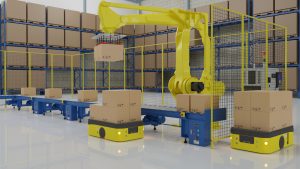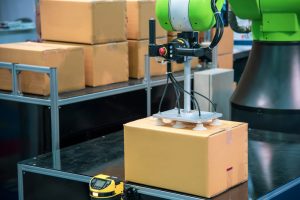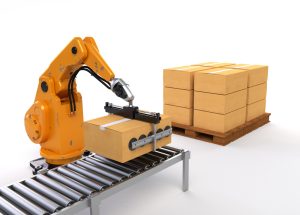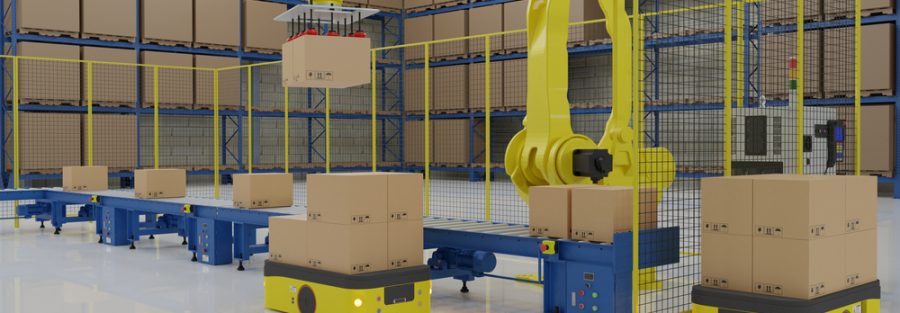PALLETIZING ROBOTS: THEIR EFFECTS ON INCOME AND PRODUCTION
 One of the areas of industrial automation that is expanding the quickest is robotic palletizing. Find out how using palletizing robots may boost output and income.
The practice of palletizing involves gathering items from one place and arranging them neatly onto a pallet. This often completes the production process just before the product is shipped or placed in long-term storage. The method of using robots to automate this task is known as robotic palletizing.
An automated palletizing system is required by many high-volume production operations. The following subjects will be covered in this post as we go over the fundamentals of robotic palletizers:
One of the areas of industrial automation that is expanding the quickest is robotic palletizing. Find out how using palletizing robots may boost output and income.
The practice of palletizing involves gathering items from one place and arranging them neatly onto a pallet. This often completes the production process just before the product is shipped or placed in long-term storage. The method of using robots to automate this task is known as robotic palletizing.
An automated palletizing system is required by many high-volume production operations. The following subjects will be covered in this post as we go over the fundamentals of robotic palletizers:
Robotic Palletizing Industries
Robotic palletizing systems are necessary for manufacturers in many different sectors. Typical industries that use this application in are:- Plastics
- Food and drink
- Retail
- Chemistry
- Medicine
Advantages of Palletizing Process Automation
 Palletizing is often done at the very end of the manufacturing process. This places it in a crucial stage to maintain product flow. This bottleneck will restrict your facility’s overall maximum throughput. It is crucial to think about automating this procedure because of this. The following dangers and restrictions are associated with manual palletizing:
Palletizing is often done at the very end of the manufacturing process. This places it in a crucial stage to maintain product flow. This bottleneck will restrict your facility’s overall maximum throughput. It is crucial to think about automating this procedure because of this. The following dangers and restrictions are associated with manual palletizing:
- Quickness
- Possibility of harm
- Capacity of payload
- Time spent on tasks consistently
- Reliability of high-quality pallets
When Is It Time to Automate?
How do you determine whether it’s time to automate a manual process? It is crucial to take into account this aspect of manufacturing as well as any other area where automation can be feasible. Based on your business, our potential finder tool assists you in identifying the automation projects in your plant that have the greatest potential. Palletizing may need to be automated by a manufacturer in a few different situations. The following are some obstacles you may encounter today:Throughput
Merely addressing these difficulties could serve as a basis for automating this work. For the majority of manufacturing processes, throughput has a significant financial impact. You and your company will make more money if you have more pieces. There’s a straightforward conclusion to be drawn from the fact that hand palletizers are slower than robotic ones. At the conclusion of the production line, robotic palletizers offer the highest possible throughput. By doing this, bottlenecks are lessened and operational efficiency is raised.Labor Costs
One of the main justifications for using a robot at a facility is to lower labor expenses. Robots are expensive initially, but they pay you back in the long run. An appropriate return on investment is often measured in the range of 6 to 18 months. It doesn’t matter if your business strategy allows for a wider range, robots will ultimately pay for themselves.Floor Space
There is a limited amount of space available for activities in manufacturing plants. As a result, expanding businesses may encounter some particular difficulties. Increasing throughput in a constrained area presents an efficiency challenge. Often, robots offer a sophisticated answer to this problem. Reallocating a manual worker often means removing additional space-consuming elements. Examples of such components include extra apparatus and ergonomics. is possible to customise automated palletizing solutions for your particular area. use the space allotted for your palletizing procedure as effectively as possible by doing this.Workplace accidents
Moving bulky products in potentially harmful ways is a common palletizing activity. Pain and muscle strains are frequent ailments. daily output is severely impacted by these injuries. and pains will, at the very least, make operators work slower. is possible for injuries to worsen to the point where recovery is required. Your efficiency may suffer as a result of having to reallocate labor to maintain output. injuries may potentially result in fines and financial compensation, depending on the regulations in your nation. Deployment of a robot palletizer can allay these worries. Naturally, unlike manual laborers, robots are not susceptible to accidents or weariness. They also don’t need breaks or sick days. With robotic palletizers, your palletizing business operates as efficiently as possible. Automating palletizing operations is a critical consideration if your company has had occupational accidents, particularly in this area.When Robotic Palletizing Isn’t Right for You
But not all operations can benefit from automated palletizing technologies. Why would you find this to be the case? Palletizing may not have the biggest effect on output in your operation; you may find that other projects are more important. Certain firms lack the manufacturing volume that frequently necessitates automation of this procedure. The influence of labor rates on your business may not be that great, depending on where you live. Furthermore, palletizing cells might be a costly undertaking. Based on the current ROI calculation, this cost may be prohibitive for certain producers. It’s critical to think about the particulars of your company and decide whether automating your palletizing process makes sense for you.The Importance of End of Arm Tooling
Palletizing robots are distinguished by their special end-of-arm tooling. The device that enables the robot to interact with the material is called end of arm tooling (EOAT). Electromagnets, mechanical grippers, and pneumatic suction devices are examples of end-of-arm tooling used in palletizing. Multiple packages may be picked up at once using end-of-arm technology that can be scaled. This gives customers the ability to choose how to maximize the productivity of their palletizing process.Additional Considerations
A robot may be integrated to enhance most palletizing procedures. A comprehensive palletizing system does, however, consist of other elements. These elements consist of:- Safety apparatuses
- Transitions
- Mobile robots and pallet conveyors
- Robot transfer units
- a safety cage
- Sensors
- Safety scanners
- Light curtains
 Additional tools that are occasionally used to move full and empty pallets into and out of the loading zone are pallet conveyors. Mobile robots, which have more adaptable and powerful capabilities, can also be utilized for this. To further automate your palletizing operation, you may combine these extra devices with your palletizing robot. Your throughput and efficiency may rise even higher as a result.
If you are interested in palletizing robots or want to know more about how to improve production efficiency. Please contact Robotnext today for advice and cost support. Details via hotline: 0909 914 837.
Additional tools that are occasionally used to move full and empty pallets into and out of the loading zone are pallet conveyors. Mobile robots, which have more adaptable and powerful capabilities, can also be utilized for this. To further automate your palletizing operation, you may combine these extra devices with your palletizing robot. Your throughput and efficiency may rise even higher as a result.
If you are interested in palletizing robots or want to know more about how to improve production efficiency. Please contact Robotnext today for advice and cost support. Details via hotline: 0909 914 837.


